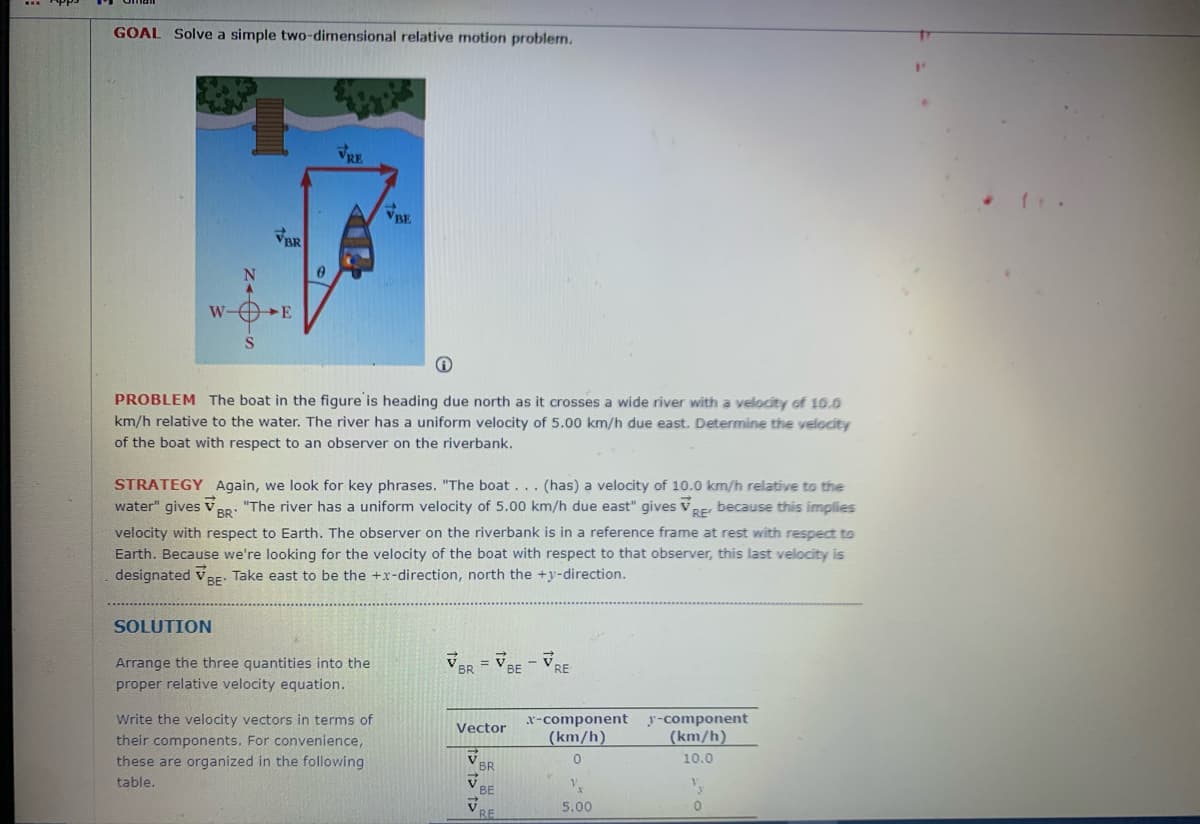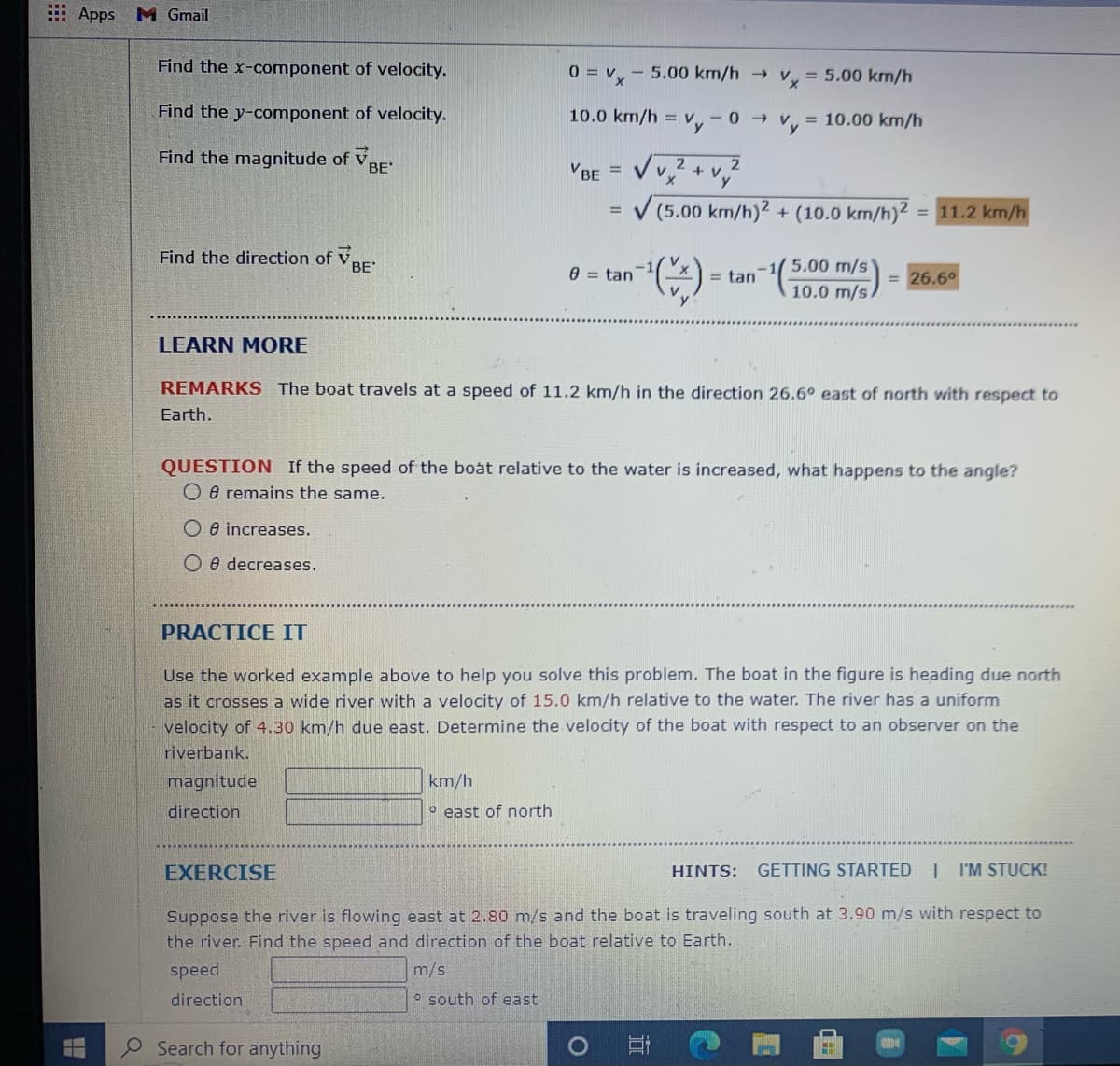QUESTION If the speed of the boat relative to the water is increased, what happens to the angle? O e remains the same. O e increases. O e decreases.
QUESTION If the speed of the boat relative to the water is increased, what happens to the angle? O e remains the same. O e increases. O e decreases.
Principles of Physics: A Calculus-Based Text
5th Edition
ISBN:9781133104261
Author:Raymond A. Serway, John W. Jewett
Publisher:Raymond A. Serway, John W. Jewett
Chapter3: Motion In Two Dimensions
Section: Chapter Questions
Problem 40P
Related questions
Question
I need steps to solve this to understand it

Transcribed Image Text:GOAL Solve a simple two-dimensional relative motion problem.
VRE
VBE
VBR
W-OE
PROBLEM The boat in the figure is heading due north as it crosses a wide river with a velocity of 10.0
km/h relative to the water. The river has a uniform velocity of 5.00 km/h due east. Determine the velocity
of the boat with respect to an observer on the riverbank.
STRATEGY Again, we look for key phrases. "The boat. . . (has) a velocity of 10.0 km/h relative to the
water" gives v BP: "The river has a uniform velocity of 5.00 km/h due east" gives vRE because this implies
velocity with respect to Earth. The observer on the riverbank is in a reference frame at rest with respect to
Earth. Because we're looking for the velocity of the boat with respect to that observer, this last velocity is
designated veE: Take east to be the +x-direction, north the +y-direction.
SOLUTION
Arrange the three quantities into the
proper relative velocity equation.
VBR =VBE - VRE
%3D
Write the velocity vectors in terms of
their components. For convenience,
these are organized in the following
x-component
(km/h)
y-component
(km/h)
Vector
10.0
BR
table.
V BE
5.00

Transcribed Image Text:E Apps M Gmail
Find the x-component of velocity.
0 = v,- 5.00 km/h v = 5.00 km/h
Find the y-component of velocity.
10.0 km/h =
= 10.00 km/h
- 0 >
Find the magnitude of VBE'
2.
VBE
%3D
V (5.00 km/h)2 + (10.0 km/h)2
= 11.2 km/h
%3D
Find the direction of VBE
5.00 m/s'
10.0 m/s.
e = tan
= tan
= 26.6°
LEARN MORE
REMARKS The boat travels at a speed of 11.2 km/h in the direction 26.6 east of north with respect to
Earth.
QUESTION If the speed of the boat relative to the water is increased, what happens to the angle?
O e remains the same.
O e increases.
O e decreases.
PRACTICE IT
Use the worked example above to help you solve this problem. The boat in the figure is heading due north
as it crosses a wide river with a velocity of 15.0 km/h relative to the water. The river has a uniform
velocity of 4.30 km/h due east. Determine the velocity of the boat with respect to an observer on the
riverbank.
magnitude
km/h
direction
° east of north
EXERCISE
HINTS:
GETTING STARTED | I'M STUCK!
Suppose the river is flowing east at 2.80 m/s and the boat is traveling south at 3.90 m/s with respect to
the river. Find the speed and direction of the boat relative to Earth.
speed
m/s
direction
O south of east
Search for anything
Expert Solution
This question has been solved!
Explore an expertly crafted, step-by-step solution for a thorough understanding of key concepts.
This is a popular solution!
Trending now
This is a popular solution!
Step by step
Solved in 2 steps with 1 images

Knowledge Booster
Learn more about
Need a deep-dive on the concept behind this application? Look no further. Learn more about this topic, physics and related others by exploring similar questions and additional content below.Recommended textbooks for you

Principles of Physics: A Calculus-Based Text
Physics
ISBN:
9781133104261
Author:
Raymond A. Serway, John W. Jewett
Publisher:
Cengage Learning

Physics for Scientists and Engineers with Modern …
Physics
ISBN:
9781337553292
Author:
Raymond A. Serway, John W. Jewett
Publisher:
Cengage Learning

Physics for Scientists and Engineers
Physics
ISBN:
9781337553278
Author:
Raymond A. Serway, John W. Jewett
Publisher:
Cengage Learning

Principles of Physics: A Calculus-Based Text
Physics
ISBN:
9781133104261
Author:
Raymond A. Serway, John W. Jewett
Publisher:
Cengage Learning

Physics for Scientists and Engineers with Modern …
Physics
ISBN:
9781337553292
Author:
Raymond A. Serway, John W. Jewett
Publisher:
Cengage Learning

Physics for Scientists and Engineers
Physics
ISBN:
9781337553278
Author:
Raymond A. Serway, John W. Jewett
Publisher:
Cengage Learning

Glencoe Physics: Principles and Problems, Student…
Physics
ISBN:
9780078807213
Author:
Paul W. Zitzewitz
Publisher:
Glencoe/McGraw-Hill

College Physics
Physics
ISBN:
9781285737027
Author:
Raymond A. Serway, Chris Vuille
Publisher:
Cengage Learning

Physics for Scientists and Engineers: Foundations…
Physics
ISBN:
9781133939146
Author:
Katz, Debora M.
Publisher:
Cengage Learning